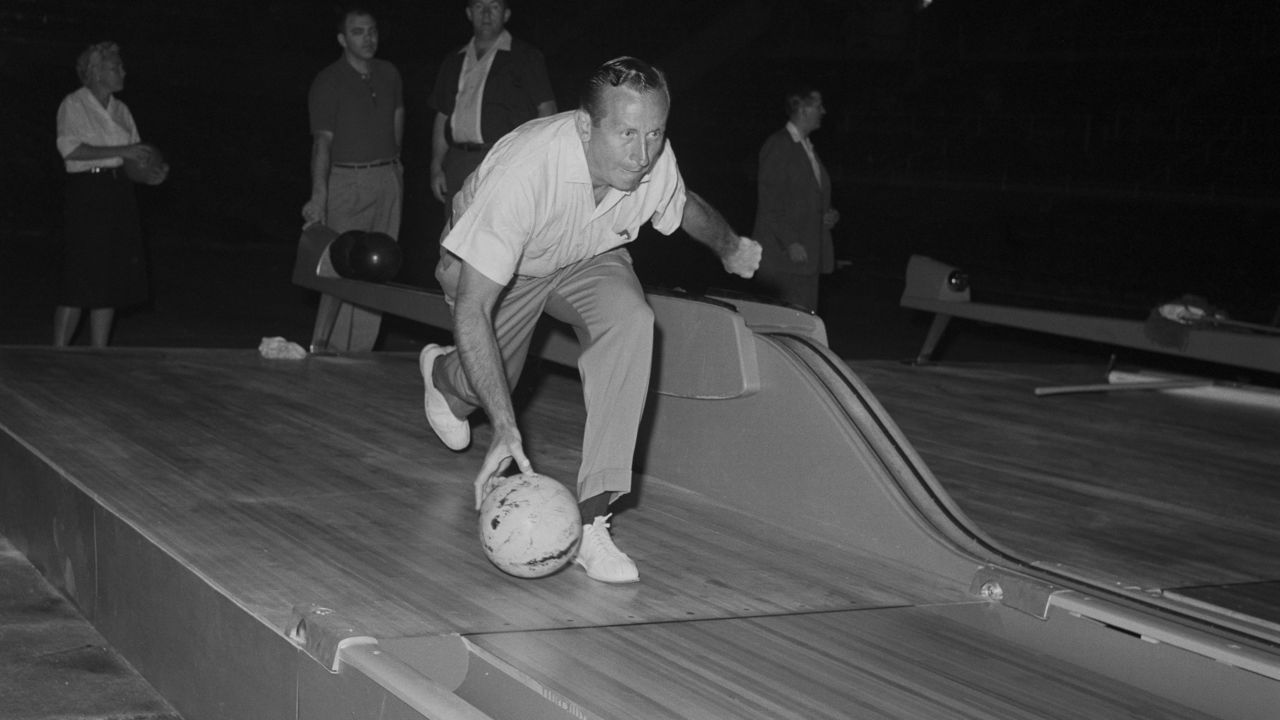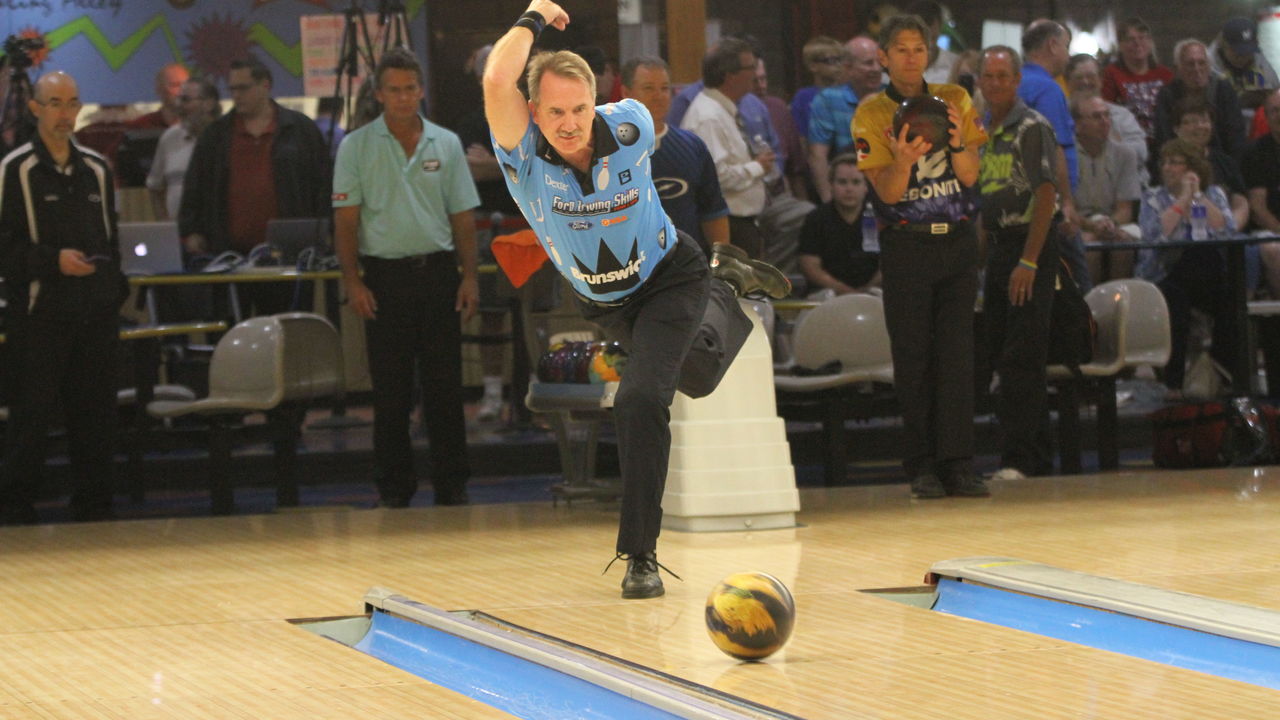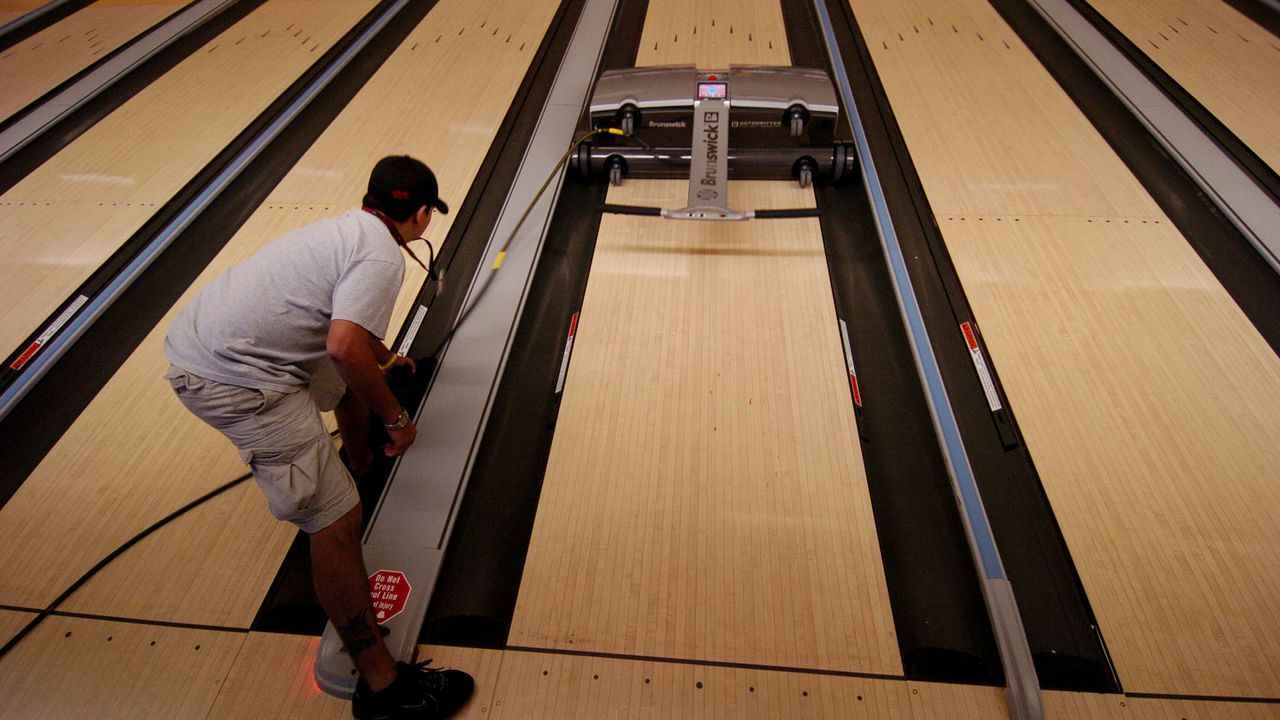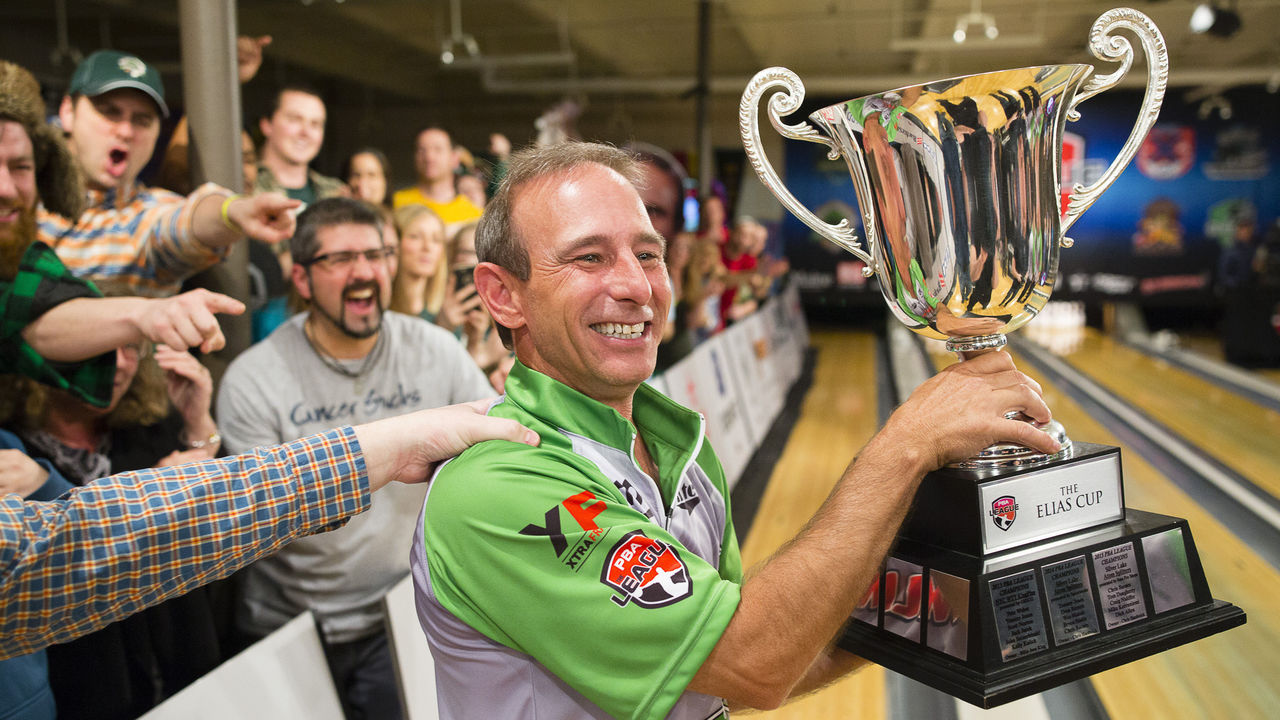Conquests, conflict, crotch chops: Inside the wild world of professional bowling
(Warning: Story contains coarse language)
Kyle Troup approaches the lane, ball in hand, his afro still, trying to ignore the noise of the Bayside Bowl crowd as he concentrates on one of the most important shots of his life.
It’s the last round of the Professional Bowlers Association (PBA) Doubles Championship. After bowling 40 games during the week to qualify for the finals, Troup and his partner, Jesper Svensson, are one strike away from beating Marshall Kent and EJ Tackett for the title.
For Troup, who'd been working as a shift manager at a Wendy's in North Carolina just 12 months earlier, being on the cusp of his second career PBA championship seems almost unbelievable. Sweetening the surreal moment is the presence of his father, Guppy Troup.
One of the world's most accomplished bowlers in the '70s and '80s, Guppy earned eight PBA titles and 41 other regional titles. Kyle spent countless hours at the lanes as a child and has never forgotten the most important lesson his father passed on: The first goal is to entertain, and the second is to bowl well.
"People tuned in to see what kind of pants I'd be wearing," Guppy once said. "They didn't care how I bowled." Faithful to his own philosophy even now, he's cheering on his son in a lime-green outfit and his signature indoor sunglasses. Though Kyle's wearing a more conservative, gray-and-white graphic print, it only serves to emphasize his full-blown afro.
But looking good is no substitute for the thrill of victory - a feeling Kyle desperately wants to experience again. Cradling the ball with both hands, he uncorks a shot that bends out a few boards to the right of center before curving back at the last second, hitting the 1-3 pocket (a right-hander's sweet spot) perfectly and sending all 10 pins scattering.
Having satisfied his father's second rule of bowling, Kyle follows the first one: He reaches into his back pocket, pulls out two hair picks, and combs his afro while encouraging the crowd in Portland, Maine to keep cheering.
After the formality of Kent and Tackett's final shots, the cameras catch Guppy staring upward, the tears in his eyes not quite hidden by his red-tinted shades.
__________
Troup's 2017 title-clinching celebration went viral, marking a rare occasion when professional bowling elbowed its way into the sports news cycle - and it didn't hurt that the doubles championship was broadcast on ESPN, giving the national audience a rare glimpse into an exciting world that was once a staple of weekend viewing.
In the 1960s, professional bowling was one of the most popular sports in America, pulling in more viewers on ABC than any other sports program. Millions were glued to their television sets every Saturday afternoon, watching the best bowlers go head to head - and if they weren't in their living rooms, fans lined up at the local alley to watch the pros in person.

Pro bowlers became the most recognizable athletes in all of sports. In 1964, Don Carter (shown above) became the first athlete in any field to receive a million-dollar endorsement deal, signing with bowling equipment manufacturer Ebonite.
But over the next several decades, as weekend sports programming options became more varied, overall interest in bowling started to dwindle. In 1997, ABC finally pulled the plug on its television broadcast. In 2000, it took three former Microsoft executives to rescue the PBA from bankruptcy by purchasing it for $5 million.
There was initial optimism that the new people in charge would usher bowling back into the national spotlight, but that hasn't happened yet. Since ABC bid it farewell, bowling's mostly operated in a vacuum, generating large-scale outside interest only when moments like Troup's go viral.
For better or worse, not much about professional bowling has changed since its heyday. There are still 10 pins to hit and two balls per frame in which to do it. The stepladder finals - in which the fourth- and fifth-ranked bowlers face off, with the winner facing the third-ranked bowler and so on, until a winner is decided - is still the prevailing PBA tournament format.
And unfortunately for professional bowlers, the prize money has also remained largely static over the past 35-plus years. In 1981, the PBA Tour produced five six-figure earners; in 2018, four players earned more than $100,000 on the lanes. By comparison, the average player salary in Major League Baseball rose from just over $185,000 in 1981 to $4.52 million last season.
But the tide could be turning, at least in terms of exposure. The PBA recently agreed to a multi-year TV deal with FOX Sports, with broadcasts starting in 2019. While that doesn't guarantee instant riches, it should expose a new batch of fans to a sport that boasts some of the fiercest rivalries, wildest moments, and oddest celebrations out there.
The drama of a bowling tournament might never compete with the Super Bowl or the Final Four, but there is plenty to admire, from the eccentricity of the sport's stars, to the physical challenges of throwing hundreds of shots per week, to the players' passion for their largely unappreciated craft. And with characters like Troup leading the way, bowling could be headed for a renaissance.
__________
Troup arrives in Wichita, Kan., in late October to compete in the PBA U.S. Open, one of the tour's major championships. A day before the qualifying round begins, Troup's wearing a red, white, and blue bowling shirt with matching pants. He remains easily identifiable, but his hair is neatly trimmed. He changed his look, he says, because he doesn't want to be known solely for his personality.
His results do speak for themselves. Troup entered the U.S. Open having cashed (that is, finished high enough in the standings to win prize money) in 16 of his previous 28 tournaments. At age 27, he's emerging as one of the best young bowlers on tour.
After Wichita, Troup's bowling itinerary will take him to Las Vegas and Hong Kong. Prior to the U.S. Open, he ventured to Sweden and Thailand.
"I'm traveling the world and doing what I love and making a living out of it," he told theScore. "I can't ask for more."

Jacob Boresch's travel plans aren't nearly as glamorous; he made an 11-hour drive from Kenosha, Wis., to Wichita the day before qualifying just to participate. And on Day 1, the 25-year-old is in last place as his father Lennie watches nervously.
At age 14, Lennie knew he wanted to become a professional bowler. He started bowling full time on the PBA Tour at 19, but he quickly realized he wasn't good enough to do it for a living. So he opened up a pro shop and continued to compete regionally.
His son Jacob grew up around the bowling alley, and when he first competed in the national Junior Gold tournament for the best youth bowlers, he finished 21st.
"I've been a junkie since," Jacob told theScore.
After graduating from Clarke University in Iowa with a degree in math and business, he's been working as a project manager and occasionally takes time off for the national tour. The U.S. Open is his fourth tournament this year.
The first-place prize money at the U.S. Open is $30,000, a far cry from some of the larger purses decades ago. The lack of money is what keeps Jacob from pursuing bowling as a career.
"How would you not want to do this?" said Jacob, who goes on to finish 118th out of 144 bowlers. "If the money was better, I would. I hate to say it. But it's the truth."
Still, the U.S. Open is a major tournament, and simply being here is special for Jacob, who's competing with people he's looked up to for a long time.
"I've always thought of bowlers as rock stars," Jacob said.

One of his long-time idols, Norm Duke, hits the stage not long after Jacob's qualifying session ends. The 54-year-old has won 38 PBA Tour titles, including seven majors. He is third on the all-time earnings list and remains a crowd favorite and a proud ambassador for the sport.
At the U.S. Open - a tournament he last won in 2011 - fans flock to Duke to say hello, start a lengthy conversation, take a photo, or get him to autograph a bowling pin. Duke, wearing a bright pink bowling shirt with his name on the back, seems to genuinely enjoy every moment.
"When they put me on a pedestal, I never think I'm deserving of any of this," Duke said. "It's amazing how much more I've gotten from bowling than I have given to it. And now I'm trying my best to give it all back."
Duke has advice for young bowlers like Jacob, who love the sport but aren't willing to risk committing to it full time.
"If you're up in the air about it, you should second-guess yourself," Duke said. "Because unless you fall for it, you'll always struggle with the decision. But if you love it, you never look back. Focus on what gets your juices flowing. It's going to be a boring life if you live it without the juices."

While athletes like Troup - and someday maybe Boresch - are tasked with putting professional bowling back on the map, there's little doubt as to who's helped keep the sport afloat during the lean times. That discussion starts and ends with Pete Weber, son of pro bowler Dick Weber and one of the most colorful personalities bowling has ever seen.
Pete, who turned 56 in August, has won 37 PBA Tour titles and a record-tying 10 major tournaments. He's second all time on the PBA money list. He's also the most successful bowler of his generation in terms of drawing attention from mainstream media.
Weber doesn't appeal to a general audience because of his titles, but rather, his celebrations - like his famous crotch chop, which he borrowed from wrestling's D-Generation X.
He's arguably best known for his reaction to winning the 2012 U.S. Open. After bowling a strike to defeat Mike Fagan, he shouted, "Who do you think you are? I am!", a catchphrase that deserved immediate induction into the sports trash-talk hall of fame. Weber's notoriety eventually made him the subject of an ESPN "30 for 30" documentary called "The Bad Boy of Bowling."
If he wasn't as unique, he thinks the sport might be more popular.
"I think bowling could use a few more Pete Webers," he told theScore. "I've always said people don't want to watch somebody go throw the bowling ball down the lane, turn around, and then walk back off the approach without doing anything. When you interact with the crowd, it's way more exciting."
Weber understands that not every bowler approves when he wears his emotions on his sleeve.
"Some like it,” he summarized, "(and) some don’t.”
The level of animosity between certain players isn't surprising. Bowlers encounter the same competitors week after week, and the familiarity breeds contempt - especially since pro bowlers often disagree about how the game should be played.
"There are flare-ups that can happen between players," Troup said. "And it's not necessarily bad for the sport."
One of the best examples is the bitter rivalry between Jason Belmonte and Sean Rash. Belmonte, 35, has won 18 PBA Tour titles and has been named PBA Player of the Year four times; Rash, 36, has won 12 PBA Tour titles and two major tournaments.
Rash and other players have accused Belmonte of distracting his opponents just as they're about to release the ball by popping the top off a water bottle, disrupting their timing and delivery.
The ill will between Belmonte and Rash, considered the two best bowlers in the world at the time, erupted into hostility at a 2011 event. Belmonte's water bottle opened when Rash was bowling, which Belmonte insists was an accident. Rash delivered a strike, then stepped off the approach and gestured toward Belmonte, shouting: "Take that, you bottle bitch!"
Rash was fined by the PBA for his comments, but the incident - and its fallout - was a boon for the sport. The rivalry eventually led to a one-on-one, three-game, total-pinfall exhibition match in 2014 that was broadcast on ESPN. Think Tiger Woods versus Phil Mickelson, but in their primes - and with the kind of theatrics that would accompany a main-event boxing match.
In the end, Belmonte secured bragging rights, winning 743-718.
Belmonte's caused controversy since he joined the PBA Tour. While the Australian has established himself as one of the best bowlers in the world, many of his contemporaries are loath to give him credit because he bowls two-handed. The issue has created clear divides among the sport's top athletes.

Some traditionalists argue that the two-handed approach is no different than using a corked bat or taking performance-enhancing drugs. It allows the bowler to generate more speed and loft on the ball, thereby making it easier to control and providing what some consider an unfair advantage. Brian Voss, the 1988 PBA Player of the Year, once called the two-handed style "a slow cancer to an already diseased sport."
Troup, who also uses two hands, sees the tactic as part of bowling's evolution.
"It's like any other sport. If you can create an advantage, you do it," he said. "If other people can't do it, they're probably mad because they can't. Look at Tiger Woods in golf, or Stephen Curry making 30-foot step-back threes. In any sport, there are playmakers that do things that other people can't. Well, two-handed bowlers, we're the playmakers in bowling. We can do what 95 percent of other bowlers can't do. For the most part, they just want to hate on it."
The criticism doesn't bother Belmonte much. He's embraced something of a villainous role, often making fun of the controversy on social media.
"Ten years ago, it used to get under my skin," Belmonte said. "Now I'm very secure with the way that I bowl. When you look around, the haters are such a minority."
__________

Between the over-the-top theatrics, wild attire, and seething interpersonal animosity, bowling's got a lot going for it from a spectator's perspective. And there's been plenty of crossover between the PBA and other pro leagues - most notably the NBA, as Chris Paul, Damian Lillard, and others have professed their love of the sport. (The PBA even named an oil pattern after Paul - more on those later.)
In 2017, more than 10 million people in the United States aged 13 or older participated in bowling, according to a study from the Sports & Fitness Industry Association. So why aren't mainstream sports fans more interested in watching it?
"Bowling is one of those sports that everybody can do," said PBA commissioner Tom Clark. "A 5-year-old can roll the ball between their legs and get a strike."
The idea that any average joe can outduel a pro is a problem. People watch sports, at least in part, to see athletes perform incredible physical feats and demonstrate the mental strength to compete in a high-pressure environment. So it makes sense for people to wonder: Why aren't the best bowlers in the world throwing perfect games every single time? Why are their scores comparable to mine on a good day at the local bowling alley?
And bowlers don't produce awe-inspiring highlights that end up on "SportsCenter," like Odell Beckham Jr. snagging a one-handed touchdown or Mike Trout hitting an ankle-high 100-mph fastball into the bleachers, contributing to the perception that they're not real professional athletes.
Perception, in fact, is a significant part of the issue. Professional bowling is much more physically challenging (and painful) than it appears, not to mention mentally taxing, and the pros are bowling on a very different surface than most casual players.
At a glance, Walter Ray Williams Jr. - an unassuming middle-aged man with greying hair and a mustache to match - looks like he may have come down to the lanes to unwind after his 9-to-5. But he's no beer-league star. In fact, he's one of the best pro bowlers of all time - some say the best ever.

Williams put himself through college with the prize money he earned at bowling tournaments. By the time he graduated, he'd saved up enough to try pursuing the sport as a career. He bought an RV and spent 30 weeks a year traveling the country to bowl professionally.
Now 59, Williams has won a record 47 PBA Tour titles and is the tour's all-time leader in earnings. He's been a model of consistency, winning his first Player of the Year award in 1986 and his most recent one in 2010; he also put together a streak of 17 consecutive seasons with at least one PBA Tour title. In his time away from the lanes, he's managed to win nine world championships in horseshoes.
"There's a lot of people who like bowling," the PBA Hall of Famer said. "They're just not as interested to watch the professionals. I don't quite understand why."
Physically, pro bowlers are similar to baseball pitchers in that they exert the same kind of force on their body over and over. Being able to repeat their delivery hundreds of times in a week is critical. It's also a perfect recipe for repetitive motion disorders like elbow, wrist, and shoulder tendinitis, among many other ailments, including back pain, herniated discs, and an assortment of knee injuries.
At each tournament, bowlers spend several days qualifying before a select few reach the elimination round. Anyone who gets that far has bowled over 50 games over that span. The schedule is extremely demanding for full-timers, and the aches and pains only compound as the years go on.
A web series called "The Pain Channel" filmed at a 2011 PBA event to document the physical perils of the sport - and the crew wasn't prepared for the wealth of available material.
"We were amazed by the consistency of injuries throughout the bowling world," web series co-founder Chad Harris told Bowling Digital. "... We were hopeful to find one or two good stories, but literally every bowler we talked to had an unbelievable story about persevering through painful injuries. We actually had to make two episodes."
Williams admits the physical aspect can be tough at times, but he's acclimated to the grind. Troup, a puppy compared to Williams, is already dealing with sciatic nerve pain that can make it difficult to get out of bed. Some days, it's a challenge to lace up his bowling shoes.
"We're athletes," said Troup, who competed abroad at the start of December but will take the rest of the month off to recuperate. "We're throwing 15-pound balls, 20 miles an hour, 20 times a game, times eight games a day. It's a workout. People that drink beer and bowl a couple of games a night, you bowl 10 games a day for five days, and let me know how your body is feeling."
Peak physical condition and talent can only take bowlers so far. When Troup became a full-time pro, he needed to improve many technical elements of his game, from his speed control to the timing of his approach. But he found the mental part of competing to be the most challenging.
After quitting his job, Troup went into every tournament feeling pressure to make a good shot in every frame. Over time, he's learned, like a baseball closer, to have a short memory.
"The great bowlers never panic," Troup said. "They'll take their good shots and their bad shots, but they're always confident."
Like a golfer staring down a 7-foot putt to win the match, bowlers are on an island, with only the ball and the pins deciding the outcome. The difference between throwing a strike and leaving a 7-10 split is often the difference between a five-figure check and an early trip home.
Williams said, "I've seen many guys with beautiful games, but they just couldn't do it."
Those beautiful games have another thing working against them: the lanes themselves. A typical alley applies oil to the lanes in a pattern that helps guide bowling balls toward the middle. Pro bowlers, however, deal with different oil patterns that are designed to hinder scoring.

The PBA library contains 20 patterns that can range in length from 32 feet to 45 feet. Many of them are named after animals, including the Chameleon, the Scorpion, the Shark, and the Cheetah. The oil pattern dictates how bowlers approach each game, and the type of shot they need to make in order to increase their probability of a strike. That level of precision and shot-making is part of what separates the pros from the rest. The patterns can contribute to lower scoring at certain tournaments, similar to PGA events that feature difficult pin placements.
As more bowling balls hit the lanes, they alter the oil pattern - so during any pro game, a bowler has to figure out how to adjust their speed and placement to increase their scoring.
This part of the game is mostly invisible to the general audience, although ESPN started using blue-tinted oil in 2013. Belmonte would like the oil to be visible for all broadcasted bowling events.
"If we could have a visual representation of the lanes, and fans can see the difficulty, it would help enhance the credibility of the players," Belmonte said.
For Clark, communicating what makes the pro game unique is critical.
"People want to watch the best in the world at something," Clark said. "And they need a way to define who's the best in the world."
Clark hopes to bring all of these elements of bowling to the forefront next year. He calls the deal with FOX a seminal moment in the tour's history - and potentially the vehicle that brings bowling back into the popular imagination as a spectator sport.
"It's the biggest thing to happen to us since we left ABC," Clark said.
The broadcasts will attempt to demonstrate the sophistication of pro bowling. A tracking system will display the trajectory, speed, and revolution rate of each ball, and the oil patterns will be showcased and explained.
A new tournament format should also help rivalries ferment. PBA bowlers will earn points at tour events throughout the year, culminating in a single-elimination tournament that will begin in June.
The broadcasts also plan to feature the tour's personalities.
"They want the stories," Troup said. "They want the juice. They want everything."
There's no shortage of storylines on offer, from the aging stars nearing the end of the road to the up-and-comers trying to balance pro bowling with better-paying day jobs.

There's hope that, if the FOX deal is a success, it will lead to more network broadcast exposure - which in turn will mean bigger sponsorship deals and eventually more prize money for the players, along with a bigger pool of potential stars. But regardless of whether the TV deal facilitates a bowling revival, the sport will soldier on, the same way it has through decades of financial uncertainty and mainstream indifference. Though the pro bowling world may deserve more attention, it doesn't need it.
"I love to bowl," Duke said. "I really do love it. It's less and less each year because of the pain involved, but this is my life, and it's always been my life."
(James Bisson and Meghan Harrison contributed to this story.)
HEADLINES
- Draymond leaves for locker room after heated exchange with Kerr
- Pelicans overcome AD's 35-point night to win 5th straight game
- Purdy's 5 TDs lead 49ers past Rivers, Colts on MNF
- Pacers' Carlisle wants NBA to review play that injured Jackson
- Bills, Chargers, Jaguars book playoff spots after Colts' loss to 49ers